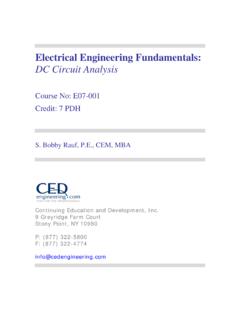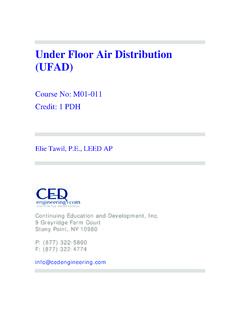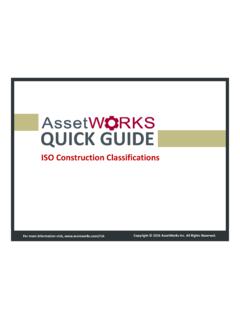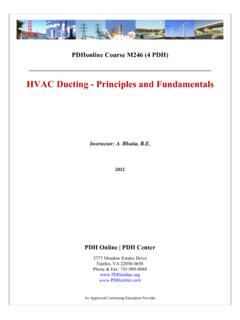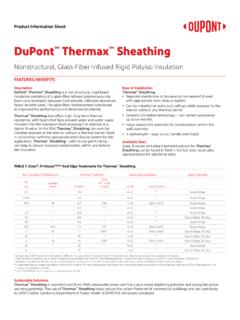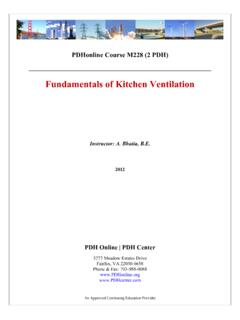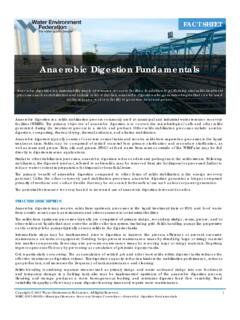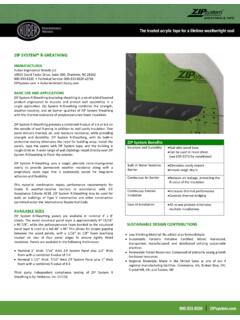Transcription of HVAC - How to Size and Design Ducts - CED Engineering
1 HVAC - How to Size and Design Ducts Course No: M06-032 Credit: 6 PDH A. Bhatia Continuing Education and Development, Stonewall CourtWoodcliff Lake, NJ 07677P: (877) HVAC HOW TO SIZE AND Design Ducts 1 CONTENTS DUCTWORK Design PRINCIPLES Basic Definitions Air Flow Principles Total Pressure, Velocity Pressure, and Static Pressure Air Flow Characteristics in Duct DUCT COMPONENTS & MATERIALS Duct Components Duct Materials DUCT CLASSIFICATION Velocity Classification Pressure classification Velocity classification v/s Pressure classification DUCT SHAPES Round Ducts Rectangular Ducts Oval Ducts Equivalent Diameter DUCT SIZING Equal friction method Velocity Reduction Method Static Regain Method PRESSURE LOSSES IN AIR DISTRIBUTION SYSTEM Duct Friction Losses Duct Fitting Dynamic Losses The Concept of Duct Equivalent Length 2 Pressure Loss across Components FAN SIZING Fan Selection Example Balancing Air Fan System
2 Effect THE SUPPLY DUCT SYSTEM Extended Plenum Systems Reducing Plenum System Reducing Trunk System Spider System Radial System Perimeter Loop System Rules of Duct Design (ACCA Manual D Residential Duct Systems) RETURN DUCT SYSTEMS Distributed Return Central Return Pressure Balancing DUCT FITTINGS AND TERMINAL UNITS Duct Fittings and Transitions Volume Control Dampers Fire and Smoke Dampers Diffusers, Grilles & Registers Location of Air Inlets and Outlets DUCT CONSTRUCTION & REINFORCEMENT Duct Construction Duct Sheet Metal Thickness 3 Aspect Ratio Standard Duct Sizes Duct Fabrication and Lengths Duct Hanger Spacing GOOD Engineering PRACTICES Energy Conservation Good Engineering Practices for Designing Ductwork DUCTWORK INSULATION AND SEALING Ductwork Insulation Ductwork Air Leakage Duct Leakage Tests Duct Sealing DUCT ATTENUATION AND NOISE CONSIDERATIONS HVAC Noise Points Acoustical Analysis of a Ductwork System DUCTWORK TESTING & SYSTEM PERFORMANCE Balancing the System Testing Methods and
3 Equipment Air Flow Measurement Instruments Determining Air Flow at Grilles Determining Air Flow in Ducts Provisions during Design for Testing, Adjusting, and Balancing DUCT CLEANING Duct Cleaning Methods Coordination between Design Specialties 4 HVAC HOW TO SIZE AND Design Ducts Air flow problems have plagued the HVAC industry for years. No matter how much money you spend on a high-quality HVAC system, the equipment won t work at its best without properly designed and installed ductwork. Ducts that are not well designed result in discomfort, high energy costs, bad air quality, and increased noise levels.
4 A well-designed ductwork system should deliver maximum interior comfort at the lowest operating cost while also preserving indoor air quality. The chief requirements of an air conditioning duct system are: 1. It should convey specified rates of air flow to prescribed locations. 2. It should be economical in combined initial cost, fan operating cost and cost of building space. 3. It should not transmit or generate objectionable noise. A primary issue is the tradeoff between the initial cost of the duct system and the energy cost of the air distribution system. Larger Ducts require a larger initial investment, but result in lower fan energy costs over the life of the system.
5 Other issues include space restrictions, noise level, capacity for expansion, appearance, etc. This course will discuss the basic fundamentals and principles of air conditioning duct Design and layout. DUCTWORK Design PRINCIPLES Starting with the basics, let's start at the most elementary level of air flow fundamentals. Basic Definitions The following basic terminology is extensively used in this course. cfm: volume of air flow; cubic feet/minute fpm: velocity or speed of air flow; feet/minute : duct size or cross-sectional area; square feet Air volume in cfm can be calculated by multiplying the air velocity by the cross-sectional area of the duct in square feet.
6 5 cfm = fpm x Area Given any two of these three quantities, the third can be readily determined: fpm = cfm/area Area = cfm/fpm Gauge and Absolute Pressures: Gauge pressure is indicated on the gauge; absolute pressure is the total of the indicated gauge pressure plus atmospheric pressure. The general equation for absolute pressure is: Gauge pressure + atmospheric pressure = absolute pressure For example, if the gauge reads 10 psig then, using the above equation, the absolute pressure would be 24. 7 psia: 10 psig + psi = psia Ordinary heating, ventilating, and air conditioning duct systems read air pressures at psi or less, often much less.
7 1 psi equals inches of water gauge; a common duct pressure of inches water column is equal to ( divided by in-wc/psi) = psi. Duct Pressure: Duct system is pressurized by three pressures: Static pressure: It is the air pressure in the duct, which is used for fan selection. Velocity pressure: It is the pressure generated by the velocity and weight of the air , which is used for measuring the flow (cfm) in a system. Total pressure: It is used to find velocity pressure. Static pressure plus velocity pressure equals total pressure. Pressure in the ductwork is measured in inches of water column (in-wc). Standard Air Density: Air has mass.
8 Standard air has a density of lbs/ ft3. System capacity is directly affected by changes in air flow. As air is heated or humidified, its specific volume increases and its density decreases. If the air density is low, more 6 cfm is required to keep the mass flow rate the same. If air density is not considered, many systems will have very low air flow. Correction for the density is however not needed in air conditioning or cooling applications, if the temperature is between 40 F to 100 F and up to 1000 ft. in elevation. Fan Capacity: The volume of air will not be affected in a given system because a fan will move the same amount of air regardless of the air density.
9 In other words, if a fan will move 3,000 cfm at 70 F, it will also move 3,000 cfm at 250 F Volumetric Air Flow Rate: The volumetric flow rate of air that will be conveyed through the duct in an air conditioning system is determined by the cooling/heat load and the desired supply air temperature. Since we are not conditioning cfms of air but rather pounds of it, we need a mass-balance equation: It is important that the air conditioning ductwork system delivers and return the right amount of air from each room and provide comfort year round. This implies room by room heat loss and heat gain calculations. Air Flow Principles Flow of air is caused as a result of pressure differential between two points.
10 Flow will originate from an area of high energy (or pressure) and proceed to area(s) of lower energy. 7 Air moves according to three fundamental laws of physics: conservation of mass, conservation of energy, and conservation of momentum. 1. Conservation of mass: It simply states that an air mass is neither created nor destroyed. From this principle it follows that the amount of air mass coming into a junction in a ductwork system is equal to the amount of air mass leaving the junction, or the sum of air masses at each junction is equal to zero. In most cases the air in a duct is assumed to be incompressible, an assumption that overlooks the change of air density that occurs as a result of pressure loss and flow in the ductwork.



